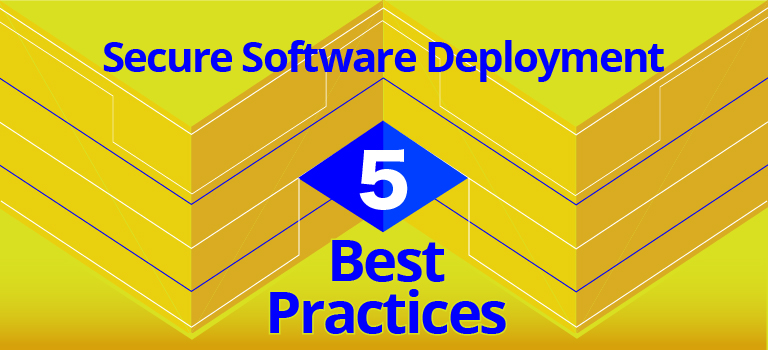Security is a part of the Software Development Life Cycle (SDLC) that needs to be made a part of every cycle process, especially deployment. Secure software deployment does not start when the software is being deployed; it starts way back when the first line of code is written.
Here are some secure software development best practices that can help you avoid problems in the long run, such as ransomware attacks or otherwise compromised security. These best practices also make sure that the speed of the deployment process is not affected.
Understand the Security Aspects of the Development Environment
You cannot implement security standards if the team does not fully understand them. Before starting with a new software project, it is important to familiarize the development team with the security best practices of the system you are working on.
For example, these Kubernetes security context settings can help a development team understand the basics of Kubernetes security. Your team having this knowledge will greatly reduce the chances of human error.
This is important because Kubernetes is one of the most rapidly growing open-source software projects in history. It is widely used for cloud-native development and deployment and having a deep understanding of Kubernetes security best practices can help the team avoid security blunders. The principles are more or less the same with other container orchestration systems.
Make Security a Part of all Phases of your Software Supply Chain
The first thing you need to do is exchange the ‘security is the final step’ thinking with the ‘security at every step’ approach. The latter is what the current software development environment, including Kubernetes, containers, and cloud-native deployment, calls for.
Container security automation should be introduced at the earlier CI/CD pipeline stages, ideally from the very first day.
Making security automation a part of the entire pipeline ensures that applications can be created and deployed safely while maintaining a good development pace. Detection of vulnerabilities and unauthorized behavior can also be made easy and efficient so that any issue can be rectified at earlier stages.
Some of the things that development teams need to be mindful of include:
- Performing container image scanning in the build phase.
- Complementing that tactic for the deployment phase by applying container admission controllers to stop any deployment that does not follow the pre-configured policies.
- Never skip implementing strict deployment policies.
- Never relying solely on runtime monitoring to catch security issues.
Use GitOps Practices
GitOps is increasingly becoming a preferred approach to secure cloud-native and Kubernetes-centric CI/CD. It offers both security and speedy deployment, two of the most desired things in any software development project in this era.
According to many leading software developers and engineers, GitOps is a set of practices that can be extremely helpful for Kubernetes environments, especially when the resources on a single cluster are being shared by multiple users or teams.
GitOps can work in tandem with Kubernetes features such as namespaces to ensure that multiple tenants use the resources in a secure manner. These practices achieve this by maintaining isolation between users and decreasing the risks of security and readability. This is especially helpful when all users are making changes.
Using a model like GitOps ensures that any change made by any users is tracked and approved before it makes it to the final build. This does not only manage application updates but can also come in handy if you want to roll back to a previous version if an update is not working the way it should.
Pay Close Attention to All the Security Related Settings
Every modern software deployment system comes with several useful security and reliability features. To get the benefits, you need to properly configure and manage them throughout the SDLC.
No matter what environment you are working in, misconfiguration of security-related settings can lead to serious security threats. Talking of Kubernetes, the most widely used container orchestration system right now, here are some suggestions:
- The use of privileged containers must be limited to cases where there is no other choice. This is because such containers and anyone with access to them have absolute privileges within the node they are installed on. If such a container is compromised, the damages can be extreme. Use the Pod Security Policy as a guideline to manage who can deploy elevated node access containers.
- Implement a proper logging mechanism. If anyone uses SSH to access a Kubernetes node, an audit server should log the access as well as all the commands executed on the server.
- Automate the TLS and authorization/authentication services using a service mesh technology.
Never Use the Default Configurations
Never using the default configurations is especially important if you are using an open-source platform like Kubernetes. The default configurations might not necessarily align with your security posture because they focus on commercial, operational, and functional success, not security. Besides, they are common knowledge, and anyone can exploit them. You can seek the help of commercial platforms and providers in such a scenario.
A prime example of this is the absence of network segmentation policies on deployments and their pods when using Kubernetes. This lets all assets communicate among themselves. This default setting is great if a developer wants to build an app fast but leaving the default settings in place means that if one container is infected, the threat can spread quickly.
Conclusion
The basis of secure software deployment is to ensure that security is taken care of throughout the development lifecycle. Some of the best practices for secure software deployment include developing an understanding of the platform you are working on, the ‘security is a part of each development step’ approach, using GitOps or similar practices, paying close attention to security settings and never using the default configurations on the infrastructure you are working on.
Adam Smith
Tags: Cybersecurity, Kubernetes, Open-source, SDLC, Software, Software Deployment, Software Security


